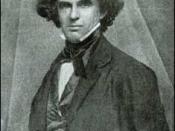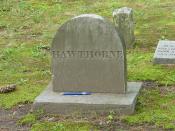Nathaniel Hawthorne, a critically acclaimed American writer of the 19th century, was born in Salem, Massachusetts in 1804. The novelist's book, The Scarlet Letter, is supposedly his best work, and universally considered a literary classic. Concerned with sin and consequences of dealing with it, Hawthorne's work relates to his own personal sense of shame about his ancestor's persecuting roles in the 17th century Salem Witch Trials. By indirectly dealing with his sense of guilt through fictional circumstances, he shows his viewpoint as being highly critical of the Puritans while teaching a strong moral lesson in the process. Graduating in the middle of his class from Bowdain College in 1825, he went on to write a variety of long stories, short stories, and articles. Generally his writings contained powerful symbolic and psychological aspects of "the effects of pride, guilt, sin, and secrecy" (Encarta, 1997).
Although many moral lessons are dealt with in the book, the most significant thesis Hawthorne proved was salvation can only be earned by being open about and true to what you are.
Using excellent characterization, description and expression he develops his thesis by showing the consequences of hiding sin, like Arthur Dimmesdale, and of publicly acknowleding it, like Hester Prynne. Through Hester's daily struggle with her public punishment to wear a scarlet letter A on her clothing to remind her and everyone in the Puritan community of her adultery, she learns how to cope with and triumph over her sin against humanity. On the other hand, Reverand Arthur Dimmesdale, Hester's equally guilty partner in the crime, refuses within himself to publicly confess his sin until the end of the novel, whereas shortly after he dies. Thus, Hawthorne summarizes the delayed importance of being truthful about oneself in his quote, "Be true! Be true! Show...


